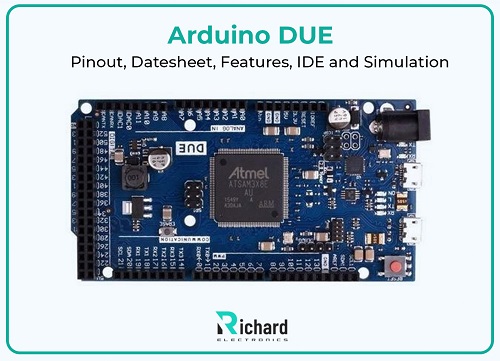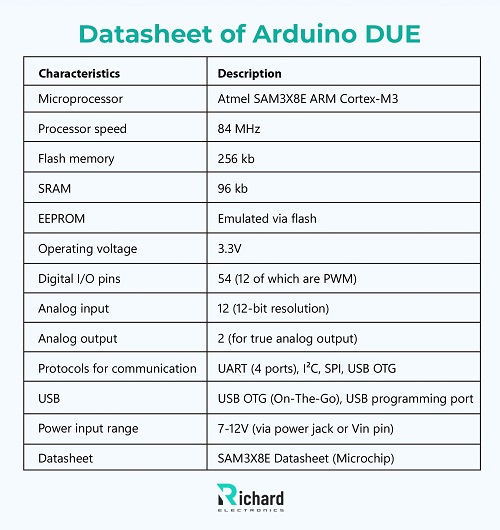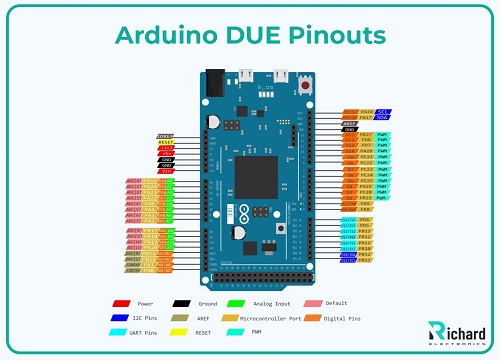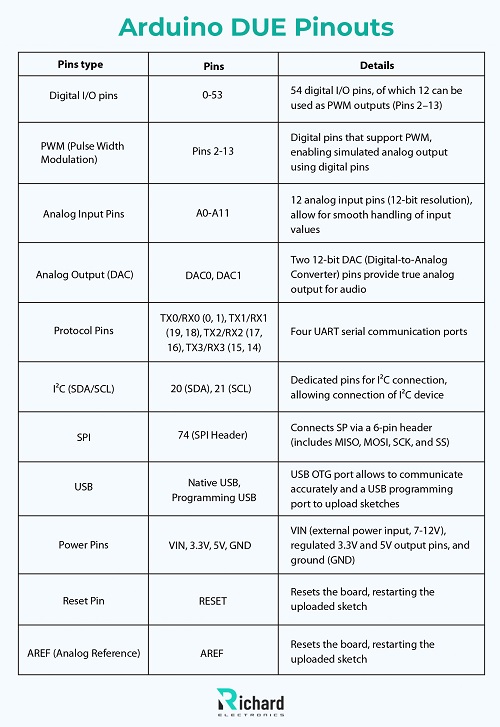Arduino DUE: Pinout, Datesheet, Features, IDE and Simulation
Arduino DUE was the first Arduino board to feature a 32-bit ARM microprocessor, specifically the SAM3X8E ARM Cortex-M3. It operates at 84 MHz, significantly faster than typical boards like those using an 8-bit ATmega328p processor running at 16 MHz. This high-speed processing makes it much faster and more powerful for complex projects. The DUE offers robust data processing capabilities, ample memory for storing data, and numerous input/output pins. It can operate on a 9V battery.
Released in October 2012, the DUE is designed as a user-friendly platform for beginners, designers, and hobbyists. Unlike 8-bit boards that were limited in handling high-speed data and memory, the DUE excels in projects requiring high processing speed and complex coding.
In this article, we will cover its datasheet, specifications, key features, pinouts, IDE, and applications, along with setup instructions and comparisons with other Arduino boards. Let's dive into the details.

### Datasheet of Arduino DUE:
The Arduino DUE stands out among other Arduino boards due to its advanced features and specifications.

| Characteristics | Description |
|----------------|-------------|
| Microprocessor | Atmel SAM3X8E ARM Cortex-M3 |
| Processor speed | 84 MHz |
| Flash memory | 256 KB |
| SRAM | 96 KB |
| EEPROM | Emulated via flash |
| Operating voltage | 3.3V |
| Digital I/O pins | 54 (12 PWM) |
| Analog input | 12 (12-bit resolution) |
| Analog output | 2 (true analog output) |
| Communication protocols | UART (4 ports), I²C, SPI, USB OTG |
| USB | USB OTG (On-The-Go), USB programming port |
| Power input range | 7-12V (via power jack or Vin pin) |
| Datasheet | SAM3X8E Datasheet (Microchip) |
### Arduino DUE Pinout:


| Pin type | Pins | Details |
|----------|------|---------|
| Digital I/O pins | 0-53 | 54 digital I/O pins, 12 support PWM |
| PWM (Pulse Width Modulation) | Pins 2-13 | Enable simulated analog output |
| Analog Input Pins | A0-A11 | 12 analog input pins with 12-bit resolution |
| Analog Output (DAC) | DAC0, DAC1 | Two 12-bit DAC pins for true analog output |
| Protocol Pins | TX0/RX0 (0, 1), TX1/RX1 (19, 18), TX2/RX2 (17, 16), TX3/RX3 (15, 14) | Four UART serial communication ports |
| I²C (SDA/SCL) | 20 (SDA), 21 (SCL) | Dedicated pins for I²C connection |
| SPI | 74 (SPI Header) | Connects via a 6-pin header (MISO, MOSI, SCK, SS) |
| USB | Native USB, Programming USB | Native USB for communication, Programming USB for uploading sketches |
| Power Pins | VIN, 3.3V, 5V, GND | External power input (7-12V), regulated 3.3V and 5V output, ground (GND) |
| Reset Pin | RESET | Resets the board, restarting the uploaded sketch |
| AREF (Analog Reference) | AREF | Sets the analog reference voltage |
### Features of Arduino DUE:
#### Processor:
The DUE uses the ARM Cortex-M3 core, enabling fast mathematical operations and high precision. It is ideal for projects requiring high processing power and accuracy.
#### Memory:
The DUE has 256 KB of flash memory, 96 KB of SRAM, and emulated EEPROM. This allows for large programs and complex coding, making it suitable for real-time data processing and embedded applications.
#### Voltage:
The DUE operates at 3.3V, making it compatible with modern devices and sensors that run on 3.3V. Directly connecting 5V to the DUE without level shifting can damage the board.
#### Variety of I/O pins:
It includes 54 digital I/O pins, 12 analog inputs, and two analog outputs. These pins support various communication protocols and allow for extensive connectivity.
#### High precision:
With 12-bit resolution on analog inputs, the DUE provides high-precision readings, essential for environmental monitoring, scientific experiments, and signal processing.
### Arduino DUE IDE and Simulation:
#### Arduino IDE:
The Arduino IDE is user-friendly and supports writing, compiling, and uploading code. It includes a code editor, library manager, serial monitor, and examples for beginners.
#### Setup for Arduino DUE:
To set up the DUE, install the Arduino IDE, select the DUE board, connect via USB, and upload your code.
#### Pros:
- Easy to use for beginners
- Wide community support and libraries
- Compatible with Windows, macOS, and Linux
#### Cons:
- Limited debugging tools
- Lacks advanced features
- No auto-complete or code suggestions
### Simulation for Arduino DUE:
#### Proteus Design Suite:
Proteus is a powerful tool for simulating circuits and testing code. It supports the DUE and offers detailed circuit design, full simulation, interactive debugging, and a comprehensive component library.
#### How to use:
Create a new project, add the DUE from the library, connect components, import code, and run the simulation.
#### Pros:
- Extensive flexibility
- Unique debugging tools
- Accurate simulation for complex projects
- Ideal for prototyping and professional use
#### Cons:
- Paid software
- Steep learning curve for beginners
### Applications of Arduino DUE:
#### Robotics and Automation:
The DUE is used in robotics and automation for controlling multiple components and real-time processing, such as robotic arms and industrial systems.
#### IoT Projects:
It handles multiple communication protocols for IoT applications, collecting and processing data from various sensors.
#### Scientific and Environmental Research:
The DUE is used in biological labs, physics experiments, and environmental monitoring systems for precise data logging.
#### Home Automation:
It controls home environments, including security, lighting, and sensor integration.
#### Audio Processing:
The DUE is used in audio applications like sound synthesis and digital music instruments.
### Conclusion:
The Arduino DUE is a versatile and powerful microcontroller board with a 32-bit ARM Cortex-M3 processor. It operates on a 9V battery and has high memory for complex programs. It efficiently runs complex coding with high precision. The DUE is ideal for applications requiring high-power resolution, such as environmental monitoring, scientific research, robotics, IoT, home automation, and industrial automation. While it has some limitations, it bridges the gap between beginner and advanced-level projects. Understanding its features and capabilities enables efficient use in various projects.
High Speed Robot,Injection Moulding Machine Robot,High Speed Automatic Power Robot,Servo System Robot
Zhejiang Golden Eagle Plastic Machinery Co.,Ltd , https://www.goldeneagle-machinery.com